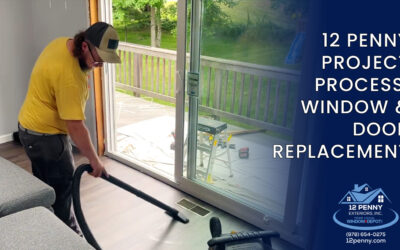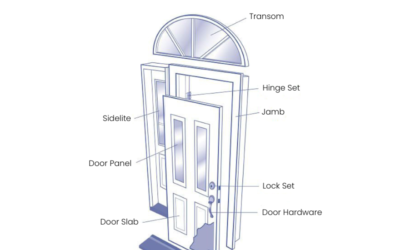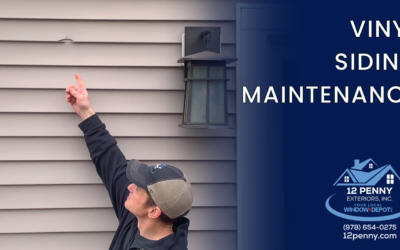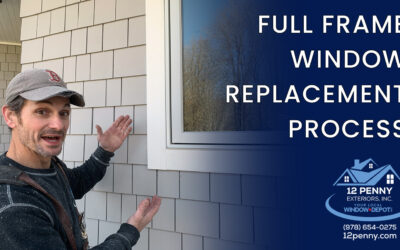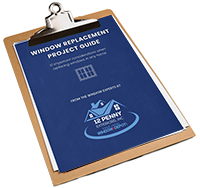If you are getting ready to replace your entry door, and are trying to cut down as much on cost as possible, you may be considering purchasing your door from a big name home center, or maybe your local lumberyard. You will pay less for a door this way, but how much do you know about the quality, warranty, and integrity of what you’re getting?
We took a closer look at a steel door purchased ‘off the shelf’ to show you what it’s made of, inside and out, and compare that to what you could get if you are able to expand your budget to consider a higher quality, custom-made product from a manufacturer like ProVia. Watch below or read on to find out some key differences.
Features we looked at:

The Label
The door we looked at was purchased from a big name retailer and cost under $500. We can see from the label that it is made of ‘premium steel’ and is Energy Star rated. The label also touts a ‘limited lifetime warranty.’ Among other details, this entry door features a reinforced lock area, sturdy steel construction, and minimal tools required for installation.
Reinforced Lock Area
First we looked at the reinforced lock area. This consists of a steel plate, about 5 inches square, that surrounds the place where the locking hardware meets the door jamb. This security feature is definitely better than nothing, but when it is compare it to the hefty steel plate that a company like ProVia puts on their door, it ends up looking a lot less impressive.
Door Finish
Next we noted that this door is primed only. It must be painted- not only front and back, but all 4 edges as well (yes, that includes the bottom). Skipping this step would leave you with an unprotected, unattractive door and a voided warranty. The comparison of a perfect factory finish on a custom door (any color you choose) to even the most carefully hand-painted door simply isn’t fair. The factory finish will win hands (brushes?) down every time.
The Jamb (aka the door frame)
This door has an all-wood jamb. Wood is a strong and sturdy material for a door jamb, but its big weakness is its ability to wick water. Many doors fail because the door jamb gets wet at the bottom, the water wicks up, and rot sets in. Once a door jamb starts to rot, there are usually other issues happening as well; additionally, since the frame and door are an integrated system, once the jamb fails, it’s generally time to replace the door and jamb together. To avoid this issue, ProVia uses a non-wicking composite material for the first 4 inches at the bottom of the jamb. Even if it gets behind any layers of paint or other sealants, water cannot wick up the jamb and cause rot to set in.
The Door Slab
Steel entry door construction consists of a steel ‘skin’ that is filled with an insulating material. The skin of the big box store door is 24 (possibly 26) gauge steel, compared with the thicker, 20 gauge steel that ProVia uses for their doors. Additionally, the big box store door is filled with a slab of foam that leaves gaps in some places and does not fully fill the cavity of the door. The foam is less dense than the closed-cell foam that ProVia fills the entire cavity of their doors with.
The Threshold
Our big box door came with a threshold that has a hollow cavity on the underside. This hollow space opens up the possibility of the threshold bending or becoming damaged over time, whereas the ProVia threshold is filled with a rigid plastic on the underside to support the integrity of the threshold, even if there isn’t space for a kick plate underneath.
The Warranty
This particular door sports a “lifetime limited warranty” (when properly painted and installed). We went online to find the fine print, which says that on the door slab, the warranty is 10 years. For the frame (jamb), the warranty is 1 year. Different doors come with different warranties, of course even within one brand’s product lineup. By comparison, ProVia’s Legacy Steel door carries an extensive and transferrable lifetime warranty.
All in all, we found that the big box, ‘off the shelf’ entry door fell short on a number of details that would contribute to the overall security and longevity of the door. While the price point for this product is relatively low, we feel that it’s important to know what you’re getting for your money. Only then can you decide if the savings are worth it for you in the long run.
If you are able to expand your entry door budget, and would like to learn more about all the features and choices available to you with a custom-manufactured door, get in touch with us, we’d be happy to walk you through the options.

